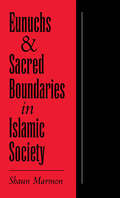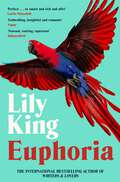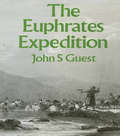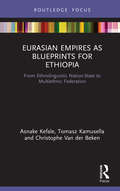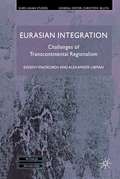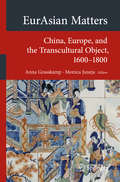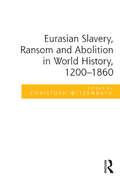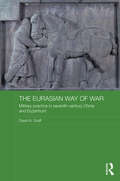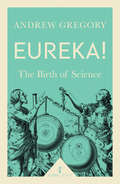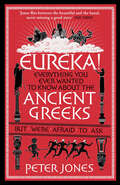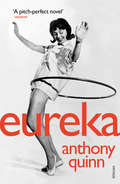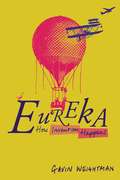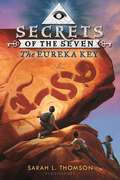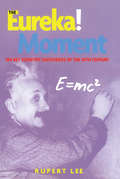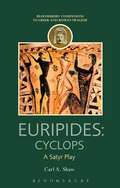- Table View
- List View
Eunuchs and Sacred Boundaries in Islamic Society (Studies in Middle Eastern History)
by Shaun MarmonIn this thought-provoking interdisciplinary work, Shaun Marmon describes how eunuchs, as a category of people who embodied ambiguity, both defined and mediated critical thresholds of moral and physical space in the household, in the palace and in the tomb of pre-modern Islamic society. The author's central focus is on the sacred society of eunuchs who guarded the tomb of the Prophet Muhammad in Medina for over six centuries and whose last representatives still perform many of their time honored rituals to this day. Through Marmon's account, the "sacred" eunuchs of Medina become historical guides into uncharted dimensions of Islamic ritual, political symbolism, social order, gender and time.
Euphoria
by Lily KingTHE NEW YORK TIMES TOP TEN BESTSELLERWINNER OF THE 2014 KIRKUS PRIZE FOR FICTIONInspired by the true story of a woman who changed the way we understand our world.In 1933 three young, gifted anthropologists are thrown together in the jungle of New Guinea. They are Nell Stone, fascinating, magnetic and famous for her controversial work studying South Pacific tribes, her intelligent and aggressive husband Fen, and Andrew Bankson, who stumbles into the lives of this strange couple and becomes totally enthralled. Within months the trio are producing their best ever work, but soon a firestorm of fierce love and jealousy begins to burn out of control, threatening their bonds, their careers, and, ultimately, their lives . . .'Dazzling' Emma Donoghue, author of Room
Euphrates Expedition
by John. S. GuestFirst published in 1992. This book invites the reader to cast the mind a hundred and fifty years back to a short span of time between 1829 and 1842. This was an exciting period when Britain’s might, demonstrated to the world at Trafalgar and Waterloo, was fortified by leadership in steam technology and was given a new direction by the liberal philosophy that British statesmen, thinkers and poets proclaimed at home and abroad. The Euphrates expedition was an attempt by well-intentioned British governments to achieve a geopolitical end by a technological means. The objective was to halt Russian expansion in the Near East, where some observers saw a threat to Britain’s control of India.
Euphrates Expedition
by John. S. GuestFirst published in 1992. This book invites the reader to cast the mind a hundred and fifty years back to a short span of time between 1829 and 1842. This was an exciting period when Britain’s might, demonstrated to the world at Trafalgar and Waterloo, was fortified by leadership in steam technology and was given a new direction by the liberal philosophy that British statesmen, thinkers and poets proclaimed at home and abroad. The Euphrates expedition was an attempt by well-intentioned British governments to achieve a geopolitical end by a technological means. The objective was to halt Russian expansion in the Near East, where some observers saw a threat to Britain’s control of India.
Eurasia
by Christopher EvansIn "Eurasia" the author describes an ideal republic where many of the problems that confront us are worked out. The book describes in an interesting and readable way how government is administered in this ideal republic. The government is one in which women take their full share of responsibility, the school children are trained in the problems they will meet in life, and more emphasis is laid on character building than on the dead languages. The children of both sexes are taught useful trades. All school children are taught to swim. The idle are employed in the construction of roads, canals and irrigation works. The problems of distribution are so arranged that the worker receives a more equitable reward for his labor.
Eurasian Empires as Blueprints for Ethiopia: From Ethnolinguistic Nation-State to Multiethnic Federation (Routledge Studies in Modern History)
by Asnake Kefale Tomasz Kamusella Christophe Van der BekenThis book is a contribution to the global history of the transfer of political ideas, as exemplified by the case of modern Ethiopia. Like many non-European nation-states, Ethiopia adopted a western model of statehood, that is, the nation-state. Unlike the postcolonial polities that have retained the mode of statehood imposed on them by their colonial powers, Ethiopia was never successfully colonized leaving its ruling elite free to select a model of ‘modern’ (western) statehood. In 1931, via Japan, they adopted the model of unitary, ethnolinguistically homogenous nation-state, in turn copied by Tokyo in 1889 from the German Empire (founded in 1871). Following the Ethiopian Revolution (1974) that overthrew the imperial system, the new revolutionary elite promised to address the ‘nationality question’ through the marxist-leninist model. The Soviet model of ethnolinguistic federalism (originally derived from Austria-Hungary) was introduced in Ethiopia, first in 1992 and officially with the 1995 Constitution. To this day the politics of modern Ethiopia is marked by the tension between these two opposed models of the essentially central European type of statehood. The late 19th-century ‘German-German’ quarrel on the ‘proper’ model of national statehood for Germany – or more broadly, modern central Europe – remains the quarrel of Ethiopian politics nowadays. The book will be useful for scholars of Ethiopian and African history and politics, and also offers a case in comparative studies on the subject of different models of national statehood elsewhere.
Eurasian Empires as Blueprints for Ethiopia: From Ethnolinguistic Nation-State to Multiethnic Federation (Routledge Studies in Modern History)
by Asnake Kefale Tomasz Kamusella Christophe Van der BekenThis book is a contribution to the global history of the transfer of political ideas, as exemplified by the case of modern Ethiopia. Like many non-European nation-states, Ethiopia adopted a western model of statehood, that is, the nation-state. Unlike the postcolonial polities that have retained the mode of statehood imposed on them by their colonial powers, Ethiopia was never successfully colonized leaving its ruling elite free to select a model of ‘modern’ (western) statehood. In 1931, via Japan, they adopted the model of unitary, ethnolinguistically homogenous nation-state, in turn copied by Tokyo in 1889 from the German Empire (founded in 1871). Following the Ethiopian Revolution (1974) that overthrew the imperial system, the new revolutionary elite promised to address the ‘nationality question’ through the marxist-leninist model. The Soviet model of ethnolinguistic federalism (originally derived from Austria-Hungary) was introduced in Ethiopia, first in 1992 and officially with the 1995 Constitution. To this day the politics of modern Ethiopia is marked by the tension between these two opposed models of the essentially central European type of statehood. The late 19th-century ‘German-German’ quarrel on the ‘proper’ model of national statehood for Germany – or more broadly, modern central Europe – remains the quarrel of Ethiopian politics nowadays. The book will be useful for scholars of Ethiopian and African history and politics, and also offers a case in comparative studies on the subject of different models of national statehood elsewhere.
Eurasian Integration: Challenges of Transcontinental Regionalism (Euro-Asian Studies)
by E. Vinokurov A. LibmanThe Eurasian continent, which has for over a century lagged behind in global markets, is currently gaining economic and political momentum. This book investigates emerging economic linkages in the area, examining the factors shaping this integration, the benefits and risks involved, and the future of these states on the global stage.
EurAsian Matters: China, Europe, and the Transcultural Object, 1600-1800 (Transcultural Research – Heidelberg Studies on Asia and Europe in a Global Context)
by Anna Grasskamp Monica JunejaThe volume examines the mutually constitutive relationship between the materiality of objects and their aesthetic meanings. Its approach connects material culture with art history, curation, technologies and practices of making. A central dimension of the case studies collected here is the mobility of objects between Europe and China and the transformations that unfold as a result of their transcultural lives. Many of the objects studied here are relatively unknown or understudied. The stories they recount suggest new ways of thinking about space, cultural geographies and the complex and often contradictory association of power and culture. These studies of transcultural objects can suggest pathways for museum experts by uncovering the multi-layered identities and temporalities of objects that can no longer be labelled as located in single regions. It is also addressed to students of art history, of European and Chinese studies and scholars of consumer culture.« This eagerly awaited volume offers deep and extensive insights into the fast-growing field of material culture studies. Its fresh approach to Eurasian objects and materialities will serve as useful reading for all scholars interested in transcultural and global studies. A very helpful introductory essay. » Sabine du Crest, University of Bordeaux Montaigne, Former Fellow, The Harvard University Center for Italian Renaissance Studies.
Eurasian Slavery, Ransom and Abolition in World History, 1200-1860
by Christoph WitzenrathRecent research has demonstrated that early modern slavery was much more widespread than the traditional concentration on plantation slavery in the context of European colonial expansion would suggest. Slavery and slave trading, though little researched, were common across wide stretches of Eurasia, and a slave economy played a vital part in the political and cultural contacts between Russia and its Eurasian neighbours. This volume concentrates on captivity, slavery, ransom and abolition in the vicinity of the Eurasian steppe from the early modern period to recent developments and explores their legacy and relevance down to the modern times. The contributions centre on the Russian Empire, while bringing together scholars from various historical traditions of the leading states in this region, including Poland-Lithuania and the Ottoman Empire, and their various successor states. At the centre of attention are transfers, transnational fertilizations and the institutions, rituals and representations facilitating enslavement, exchanges and ransoming. The essays in this collection define and quantify slavery, covering various regions in the steppe and its vicinity and looking at trans-cultural issues and the implications of slavery and ransom for social, economic and political connections across the steppe. In so doing the volume provides both a broad overview of the subject, and a snapshot of the latest research from leading scholars working in this area.
Eurasian Slavery, Ransom and Abolition in World History, 1200-1860
by Christoph WitzenrathRecent research has demonstrated that early modern slavery was much more widespread than the traditional concentration on plantation slavery in the context of European colonial expansion would suggest. Slavery and slave trading, though little researched, were common across wide stretches of Eurasia, and a slave economy played a vital part in the political and cultural contacts between Russia and its Eurasian neighbours. This volume concentrates on captivity, slavery, ransom and abolition in the vicinity of the Eurasian steppe from the early modern period to recent developments and explores their legacy and relevance down to the modern times. The contributions centre on the Russian Empire, while bringing together scholars from various historical traditions of the leading states in this region, including Poland-Lithuania and the Ottoman Empire, and their various successor states. At the centre of attention are transfers, transnational fertilizations and the institutions, rituals and representations facilitating enslavement, exchanges and ransoming. The essays in this collection define and quantify slavery, covering various regions in the steppe and its vicinity and looking at trans-cultural issues and the implications of slavery and ransom for social, economic and political connections across the steppe. In so doing the volume provides both a broad overview of the subject, and a snapshot of the latest research from leading scholars working in this area.
The Eurasian Way of War: Military Practice in Seventh-Century China and Byzantium (Asian States and Empires)
by David A. GraffThis book is a comparative study of military practice in Sui-Tang China and the Byzantine Empire between approximately 600 and 700 CE. It covers all aspects of the military art from weapons and battlefield tactics to logistics, campaign organization, military institutions, and the grand strategy of empire. Whilst not neglecting the many differences between the Chinese and Byzantines, this book highlights the striking similarities in their organizational structures, tactical deployments and above all their extremely cautious approach to warfare. It shows that, contrary to the conventional wisdom positing a straightforward Western way of war and an "Oriental" approach characterized by evasion and trickery, the specifics of Byzantine military practice in the seventh century differed very little from what was known in Tang China. It argues that these similarities cannot be explained by diffusion or shared cultural influences, which were limited, but instead by the need to deal with common problems and confront common enemies, in particular the nomadic peoples of the Eurasian steppes. Overall, this book provides compelling evidence that pragmatic needs may have more influence than deep cultural imperatives in determining a society’s "way of war."
The Eurasian Way of War: Military Practice in Seventh-Century China and Byzantium (Asian States and Empires)
by David A. GraffThis book is a comparative study of military practice in Sui-Tang China and the Byzantine Empire between approximately 600 and 700 CE. It covers all aspects of the military art from weapons and battlefield tactics to logistics, campaign organization, military institutions, and the grand strategy of empire. Whilst not neglecting the many differences between the Chinese and Byzantines, this book highlights the striking similarities in their organizational structures, tactical deployments and above all their extremely cautious approach to warfare. It shows that, contrary to the conventional wisdom positing a straightforward Western way of war and an "Oriental" approach characterized by evasion and trickery, the specifics of Byzantine military practice in the seventh century differed very little from what was known in Tang China. It argues that these similarities cannot be explained by diffusion or shared cultural influences, which were limited, but instead by the need to deal with common problems and confront common enemies, in particular the nomadic peoples of the Eurasian steppes. Overall, this book provides compelling evidence that pragmatic needs may have more influence than deep cultural imperatives in determining a society’s "way of war."
Eureka!: The Birth of Science (Icon Science)
by Andrew GregoryMedicine, anatomy, astronomy, mathematics and cosmology, science began with the Greeks, and Plato, Aristotle, Pythagoras, Archimedes and Hippocrates were amongst its stars. That man ever managed to develop a 'scientific' attitude to the natural world at all is one of the true wonders of human thought. Eureka! shows how, free from intellectual and religious dogma, these early thinkers rejected myths and capricious gods and, in distinguishing between the natural and supernatural, effectively discovered nature. Andrew Gregory, Professor of History and Philosophy of Science at University College London, unravels the genesis of science in this fascinating exploration of the origins of Western civilisation, and our desire for a rational, legitimating system of the world.
Eureka!: Everything You Ever Wanted to Know About the Ancient Greeks But Were Afraid to Ask (Classic Civilisations)
by Peter JonesThe ancient Greeks gave us our alphabet and much of our scientific, medical and cultural language; they invented democracy, atomic theory, and the rules of logic and geometry; laid the foundations of philosophy, history, tragedy and comedy; and debated everything from the good life and the role of women, to making sense of foreigners and the best form of government, all in the most sophisticated terms.But who were they? In Eureka!, Peter Jones tells their epic story, which begins with the Trojan War and ends with the rise of the Roman Empire, by breaking down each major period into a series of informative nuggets. Along the way he introduces the major figures of the age, including Homer, Socrates, Plato, Aristotle, Alexander the Great, Euclid and Archimedes; explores the Greek myths and the role of the gods;provides fascinating insights into everyday life in ancient times; and shows us the very foundations of Western culture. Eureka! is both entertaining and illuminating, and will delight anyone who ever wanted to know more about our ancient ancestors.
Eureka
by Anthony Quinn'Powered by a satisfactorily pacy plot and oiled by Quinn’s effortless prose, this is a book that slips down as easily as a gin-and-it' GuardianSummer, 1967. As London shimmers in a heat haze and swoons to the sound of Sergeant Pepper, a mystery film – Eureka – is being shot by German wunderkind Reiner Werther Kloss. The screenwriter, Nat Fane, would do anything for a hit but can’t see straight for all the acid he’s dropping. Fledgling actress Billie Cantrip is hoping for her big break but can’t find a way out of her troubled relationship with an older man. And journalist Freya Wyley wants to know why so much of what Kloss touches turns to ash in his wake.
Eureka: How Invention Happens
by Gavin WeightmanTracing the long pre-history of five twentieth-century inventions which have transformed our lives, Gavin Weightman reveals a fantastic cast of scientists and inspired amateurs whose ingenuity has given us the airplane, television, bar code, personal computer, and mobile phone. Not one of these inventions can be attributed to a lone genius who experiences a moment of inspiration. Nearly all innovations exist in the imagination before they are finally made to work by the hard graft of inventors who draw on the discoveries of others. While the discoveries of scientists have provided vital knowledge which has made innovation possible, it is a revelation of Weightman’s study that it is more often than not the amateur who enjoys the “eureka moment” when an invention works for the first time. Filled with fascinating stories of struggle, rivalry, and the ingenuity of both famous inventors and hundreds of forgotten people, Weightman’s captivating work is a triumph of storytelling that offers a fresh take on the making of our modern world.
The Eureka Key (Secrets of the Seven)
by Sarah L. ThomsonWhen middle school puzzle master Sam and history wiz Martina win a contest for a summer trip across the US, they discover they've been drafted into something vastly more extraordinary. Joining another kid on the trip, Theo, a descendant of George Washington himself, they must follow clues to find seven keys left behind by the Founding Fathers. Together the keys unlock Benjamin Franklin's greatest invention--a secret weapon intended to defend the country. Each key is hidden in a unique location around the U.S., protected with puzzles, riddles, and traps. This has kept the weapon safe . . . until now! Gideon Arnold, a dangerous descendant of the infamous Benedict Arnold, is on the chase. In competition with Arnold and his thugs to reach the artifacts first, Sam, Martina, Theo, and readers must use their wits to solve ingenious puzzles, escape death-by-booby-trap, and, by the end of the series, save our nation by uncovering many of its greatest secrets.
The Eureka! Moment: 100 Key Scientific Discoveries of the 20th Century
by Rupert LeeGenius, Einstein said, is 99% perspiration. The other 1%--the moment of inspiration and insight--provides some of the best stories of our time. From superconductors to the Big Bang, the best tales of scientific revelation are collected in The Eureka! Moment , an addictive tour through the modern world's key scientific discoveries. Rupert Lee's accounts transport readers to the moment of realization: the inventor's laboratory, his or her doubts, initial setbacks, feuds with other scientists, and finally the shock and excitement of triumph. Together, these biographies of inspiration paint an astonishing picture of human ingenuity. In physics we learn how scientists for Bell Labs inadvertently supplied proof for the Big Bang theory while trying to eliminate the background hiss in their microwave antenna. In astronomy we see Hubble's recognition that the universe is expanding, not static, as well as the fortuitous discovery of Pluto by a farm boy from Kansas. We join Watson and Crick as they decode the double helix of DNA, and Karl von Frisch as he deciphers the honeybee's waggle dance. Skillfully written to clarify concepts from quarks to relativity to antibodies for the lay reader, The Eureka Moment is a must-read for anyone interested in popular science and the history of invention.
The Eureka! Moment: 100 Key Scientific Discoveries of the 20th Century
by Rupert LeeGenius, Einstein said, is 99% perspiration. The other 1%--the moment of inspiration and insight--provides some of the best stories of our time. From superconductors to the Big Bang, the best tales of scientific revelation are collected in The Eureka! Moment , an addictive tour through the modern world's key scientific discoveries. Rupert Lee's accounts transport readers to the moment of realization: the inventor's laboratory, his or her doubts, initial setbacks, feuds with other scientists, and finally the shock and excitement of triumph. Together, these biographies of inspiration paint an astonishing picture of human ingenuity. In physics we learn how scientists for Bell Labs inadvertently supplied proof for the Big Bang theory while trying to eliminate the background hiss in their microwave antenna. In astronomy we see Hubble's recognition that the universe is expanding, not static, as well as the fortuitous discovery of Pluto by a farm boy from Kansas. We join Watson and Crick as they decode the double helix of DNA, and Karl von Frisch as he deciphers the honeybee's waggle dance. Skillfully written to clarify concepts from quarks to relativity to antibodies for the lay reader, The Eureka Moment is a must-read for anyone interested in popular science and the history of invention.
Euripides: Hecuba (Companions to Greek and Roman Tragedy)
by Helene P. FoleyChosen as one of the ten canonical plays by Euripides during the Hellenistic period in Greece, Hecuba was popular throughout Antiquity. The play also became part of the so-called 'Byzantine triad' of three plays of Euripides (along with Phoenician Women and Orestes) selected for study in school curricula, above all for the brilliance of its rhetorical speeches and quotable traditional wisdom. Translations into Latin and vernacular languages, as well as stage performances emerged early in the sixteenth century. The Renaissance admired the play for its representation of the extraordinary suffering and misfortunes of its newly-enslaved heroine, the former queen of Troy Hecuba, for the courageous sacrificial death of her daughter Polyxena, and for the beleaguered queen's surprisingly successful revenge against the unscrupulous killer of her son Polydorus. Later periods, however, developed reservations about the play's revenge plot and its unity. Recent scholarship has favorably reassessed the play in its original cultural and political context and the past thirty years have produced a number of exciting staged productions. Hecuba has emerged as a profound exploration of the difficulties of establishing justice and a stable morality in post-war situations. This book investigates the play's changing critical and theatrical reception from Antiquity to the present, its mythical and political background, its dramatic and thematic unity, and the role of its choruses.
Euripides: Hecuba (Companions to Greek and Roman Tragedy)
by Helene P. FoleyChosen as one of the ten canonical plays by Euripides during the Hellenistic period in Greece, Hecuba was popular throughout Antiquity. The play also became part of the so-called 'Byzantine triad' of three plays of Euripides (along with Phoenician Women and Orestes) selected for study in school curricula, above all for the brilliance of its rhetorical speeches and quotable traditional wisdom. Translations into Latin and vernacular languages, as well as stage performances emerged early in the sixteenth century. The Renaissance admired the play for its representation of the extraordinary suffering and misfortunes of its newly-enslaved heroine, the former queen of Troy Hecuba, for the courageous sacrificial death of her daughter Polyxena, and for the beleaguered queen's surprisingly successful revenge against the unscrupulous killer of her son Polydorus. Later periods, however, developed reservations about the play's revenge plot and its unity. Recent scholarship has favorably reassessed the play in its original cultural and political context and the past thirty years have produced a number of exciting staged productions. Hecuba has emerged as a profound exploration of the difficulties of establishing justice and a stable morality in post-war situations. This book investigates the play's changing critical and theatrical reception from Antiquity to the present, its mythical and political background, its dramatic and thematic unity, and the role of its choruses.
Euripides: A Satyr Play (Companions to Greek and Roman Tragedy)
by Carl A. ShawWith its ribald chorus of ithyphallic, half-man / half-horse creatures, satyr drama was a peculiar part of the Athenian theatrical experience. Performed three times each year after a trilogy of tragedies, it was an integral part of the 5th- and 4th-century City Dionysia, a large festival in honour of the god Dionysus. Euripides: Cyclops is the first book-length study of this fascinating genre's only complete, extant play, a theatrical version of Odysseus' encounter with the monster Polyphemus. Shaw begins with a look at the history of the genre, following its development from early 6th-century religious processions up to the Hellenistic era. He then offers a comprehensive analysis of the Cyclops' plot and performance, using the text (alongside ancient literary fragments and visual evidence) to determine the original viewing experience: the stage, masks, costumes, actions and emotions. A detailed examination of the text reveals that Euripides associates and distinguishes his version of the story from previous iterations of the myth, especially book nine of Homer's Odyssey. Euripides handles many of the same themes as his predecessors, but he updates the Cyclops for the Athenian stage, adapting his work to reflect and comment upon contemporary religious, philosophical and literary-musical trends.
Euripides: A Satyr Play (Companions to Greek and Roman Tragedy)
by Carl A. ShawWith its ribald chorus of ithyphallic, half-man / half-horse creatures, satyr drama was a peculiar part of the Athenian theatrical experience. Performed three times each year after a trilogy of tragedies, it was an integral part of the 5th- and 4th-century City Dionysia, a large festival in honour of the god Dionysus. Euripides: Cyclops is the first book-length study of this fascinating genre's only complete, extant play, a theatrical version of Odysseus' encounter with the monster Polyphemus. Shaw begins with a look at the history of the genre, following its development from early 6th-century religious processions up to the Hellenistic era. He then offers a comprehensive analysis of the Cyclops' plot and performance, using the text (alongside ancient literary fragments and visual evidence) to determine the original viewing experience: the stage, masks, costumes, actions and emotions. A detailed examination of the text reveals that Euripides associates and distinguishes his version of the story from previous iterations of the myth, especially book nine of Homer's Odyssey. Euripides handles many of the same themes as his predecessors, but he updates the Cyclops for the Athenian stage, adapting his work to reflect and comment upon contemporary religious, philosophical and literary-musical trends.
